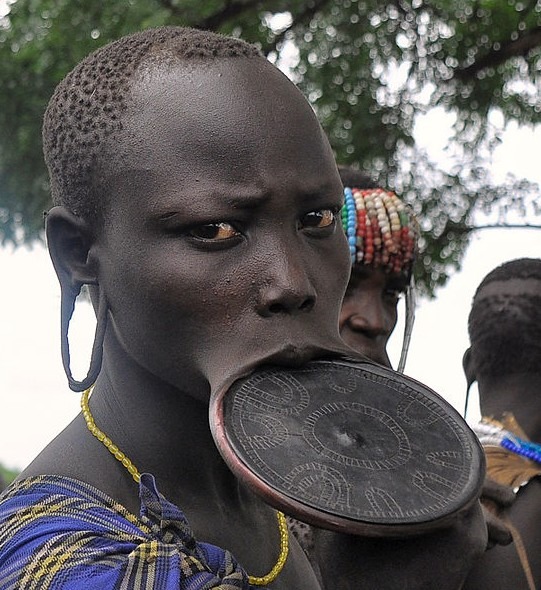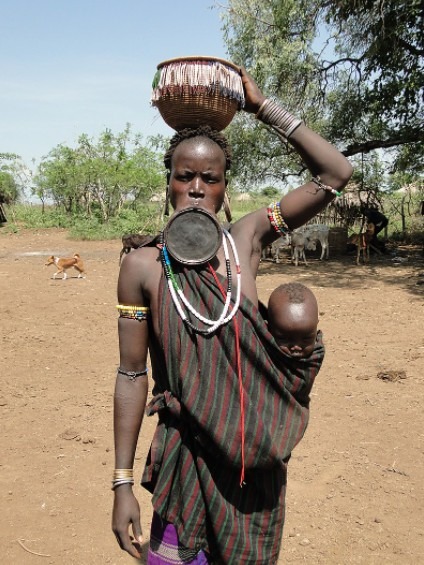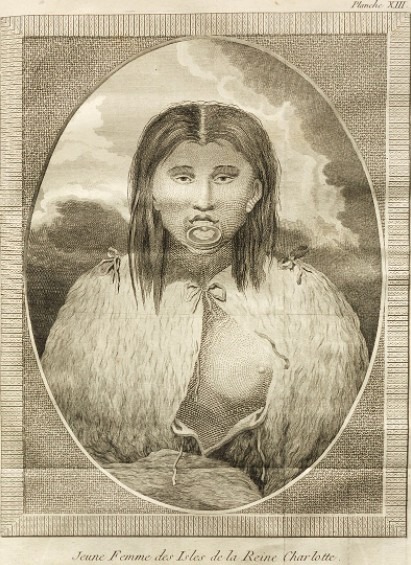Talking about the strangest traditions and customs around the world can be very shocking. It would be best if you were open-minded to believe what you read as no two cultures or groups think alike. Some parts of the world might be more gender-specific and have their traditions aligned, while some have evolved regarding gender stereotypes.
Similarly, some parts of the world might be very welcoming to the idea of body modification, while others loathe it. Such is the case of lip stretching in Africa.

The Mursi Tribe

Found in the southwest region of Ethiopia, the Mursi Tribe lives in the valley of the River Omo. According to the archaeologists working hard to understand what our planet has endured, the Omo Valley holds some of the oldest human remains. The Mursi Tribe is well-known for following those ancient practices and traditions set by their ancestors, such as lip plating, which particularly catches attention.
Mursi Tribe is one of the last ones in Africa which has still kept this ancient tradition alive. It is still considered a norm for women to go through the painful procedure of lip plating. It is an old form of body modification wherein discs of varying sizes are inserted into the lips of young women.
These discs are mostly made from clay or wood and are called “labret.” Although “labret” is a general term used to denote all types of ornaments for pierced lips, it is mostly used in terms of lip plates.
Lip Plating in Africa and Ethiopia
A few African countries also follow this tradition wherein the lip plate is inserted into the front teeth. Tribes, known as Sara and Lobi of Chad, also insert lip plates into the upper lip of young women, while others such as Makonde of Tanzania and Mozambique insert it into the lower lip.
For those who love playing online casinos, you can also visit the link to learn how to choose the most trusted South African online casinos.
What is it, and How Is It Done?
In the Mursi Tribe in Ethiopia, a young girl has to have her lip pierced. The mother mostly does it, but other older women in the family can also perform this. The lower lip of the girl is cut and held open by a wooden device. The wooden plug stays put until the cut is fully healed. It can take up to three months approximately.
It is known through observations and readings that young girls choose to decide how far the lip-stretch should be. If a girl aims for a bigger plate, she can get her lip incision bigger by installing bigger wooden clips. The biggest plate women of this tribe have worn is 12 centimeters in diameter.
History and Logic behind Lip Stretching

Young, unmarried girls or newlywed women mostly wear lip plates. Women are known to wear them particularly on some occasions, such as milking cows, serving food to the men, and weddings. There is no correct historical account of why this practice takes place. However, it is acclaimed that lip plating or stretching is directly associated with women’s worth in society.
It is one of the highest beauty standards in the Mursi Tribe, which also determines how wealthy the girl will be when she gets married. It is speculated that Mursi women have their dowry set based on the size of their lip plates.
Lip stretching is also considered equivalent to denoting that the girl is fertile and ready for marriage. It is a sign to send signals among the tribe that the girl has matured and is ready to be bonded. Besides being majorly related to defining women’s worth and femininity in society, lip stretching or plating is the true mark of identity of the Mursi Tribe. It sets them apart from the other African tribes.
A popular theory about this lip plating’s history is that the Africans did this to their women to make them appear ugly to the slave raiders. However, this theory is not given much importance as this African tradition dates back to before slave trading and raiding. Therefore, there is no definite historic account related to this ancient tradition.
It is also speculated that in addition to being the highest sign of beauty in the Mursi women, the lip plating also denotes the bravery and perseverance of these women. From the incision to the wound healing and lip stretching, if a woman can endure such harsh body modification, she is ready to become a mother and fulfil her duties of managing the household.
Women of the Mursi Tribe take a lot of pride in their lip plates. The first plate inserted after the wound is healed is made of clay. Anthropologists deny the fact that the size of the lip plates indicates the number of cattle the bride gets upon her marriage. The value of this lip ornament is heavily related to the self-esteem of the women.
What is Happening Currently?
Similar to how countless cultural traditions are now transformed into commercial activities, lip stretching or plating has also become highly commercialized. Tourists from all over the globe interested in cultures visit the Mursi Tribe and get their pictures clicked. This ancient tradition is widely considered an accepted form of body modification nowadays.
During the early 1930s, lip plating was shown to the people in the US in a circus arranged by Ringling Bros. and Barnum & Bailey Circus. Thirteen African native women were showcased in the circus under the title of Ubangi Savages.
The term Ubangi did not even come close to the real name of the African tribe. It was just used so that the circus audience could find it weird. It was the first step to the commercialization of this tradition. It is a sad reality that this age-old tradition of lip plating or stretching has become the source of money for the Africans.
source: mentalitch.com







